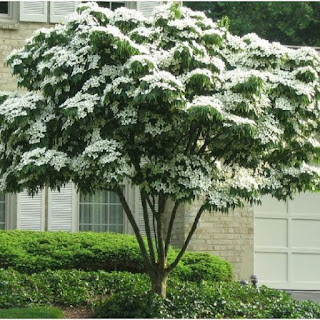Thank you to Marie Davidson of Forest Acres for spurring me on to take this a little further after responding on Nextdoor.com, to my article: https://shootsandmatters.blogspot.com/2018/08/those-fewer-but-dazzling-dogwoods.html.
 The kousa dogwood pictured (Ain't she gorgeous?) is less susceptible to other dogwood pests and diseases, particularly dogwood anthracnose, but there are other hybrid cultivars of dogwoods which fair just as well. I am providing a list of some of these varieties below.
The kousa dogwood pictured (Ain't she gorgeous?) is less susceptible to other dogwood pests and diseases, particularly dogwood anthracnose, but there are other hybrid cultivars of dogwoods which fair just as well. I am providing a list of some of these varieties below.This cross-breeding between Cornus kousa and Cornus florida didn't happen overnight or even over several years - how about a quarter-century.
I contacted several nurseries in the area and it was an educational experience for both. Depending on demand, and I hope this increases in our area, some have kousa dogwoods on hand and a few of the hybrids, but all seemed willing to source the others if they are able. I am not shorting the others, but Glenn Cooper of Cooper's Nursery, after describing what I was looking for in these species/cultivars, did some checking with suppliers and got back with me quite quickly. Of course, I always enjoy discussing plants with Tonya at Crabtree - she's part flower, part earth and part hardwood.
If you need us to do the selection, placement, installation, mulch bed and perhaps some dedicated irrigation, please give me a call - 803-553-5757.
Dogwoods are great specimen, shade and border trees - when spaced properly, but don't go crepe myrtle crazy (my favorite, except when murdered) and start planting them within two feet of your home, in your carport of where they eventually enter your living room and drop fruit in your newborn's crib. Ease up and enjoy them for what they are - beautiful blooms, gorgeous branch structure (may need some sound pruning along the way - call us), wonderful foliage color change and berries which aren't going to choke your dog or your lawn mower.
The following is a list of the hybrids I mentioned above (Thanks to The Morton Arboretum):
These cultivars belong to the Stellar® series developed at
Rutgers University.
Aurora® (Cornus x rutgersensis 'Rutban') has white floral
bracts and flowers very heavily. This is
a vigorous grower and has a form that is more spreading than other
white-flowered cultivars. Shows good
resistance to powdery mildew and dogwood anthracnose. Twenty year old specimens
are 20 feet high and wide.
Celestial® (Cornus x rutgersensis 'Rutdan') has creamy white
floral bracts and flowers heavily. This
is another vigorous cultivar, but with a more upright form. Shows good resistance to powdery mildew and
dogwood anthracnose.
Constellation® (Cornus x rutgersensis 'Rutcan') has creamy
white floral bracts and flowers heavily.
This is another vigorous cultivar, but with a very erect form. Shows good resistance to powdery mildew and
dogwood anthracnose. Twenty year old
specimens are 20 feet high and 17 feet wide.
Ruth Ellen® (Cornus x rutgersensis 'Rutlan') has brilliant
white floral bracts. This is another
vigorous cultivar. Shows good resistance
to powdery mildew and dogwood anthracnose.
Stardust® (Cornus x rutgersensis 'Rutfan') has white floral
bracts. This is vigorous cultivar with a
low-branching habit, branching low to the ground. Shows good resistance to powdery mildew and
dogwood anthracnose.
Stellar Pink® (Cornus x rutgersensis 'Rutgan') has pink
floral bracts. This is a vigorous
cultivar with an erect habit. Shows good
resistance to powdery mildew and dogwood anthracnose. Twenty year old specimens are 23 feet high
and 18 feet wide.


No comments:
Post a Comment